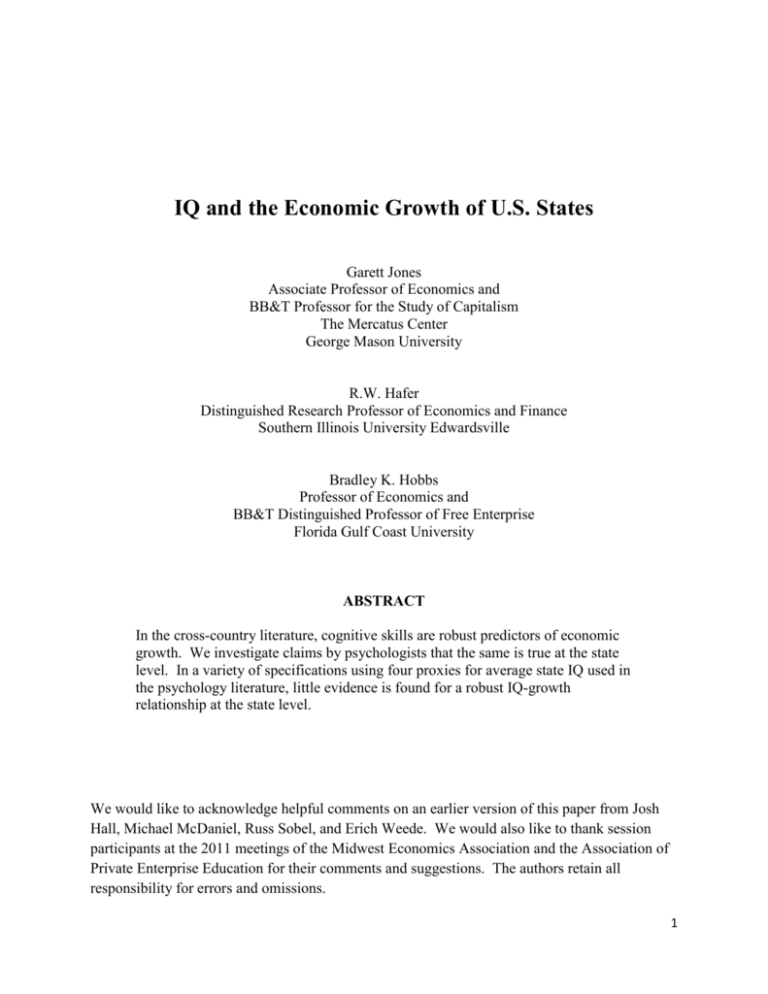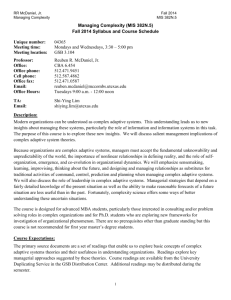GHH_paper_June_2011_version_1_
advertisement

IQ and the Economic Growth of U.S. States Garett Jones Associate Professor of Economics and BB&T Professor for the Study of Capitalism The Mercatus Center George Mason University R.W. Hafer Distinguished Research Professor of Economics and Finance Southern Illinois University Edwardsville Bradley K. Hobbs Professor of Economics and BB&T Distinguished Professor of Free Enterprise Florida Gulf Coast University ABSTRACT In the cross-country literature, cognitive skills are robust predictors of economic growth. We investigate claims by psychologists that the same is true at the state level. In a variety of specifications using four proxies for average state IQ used in the psychology literature, little evidence is found for a robust IQ-growth relationship at the state level. We would like to acknowledge helpful comments on an earlier version of this paper from Josh Hall, Michael McDaniel, Russ Sobel, and Erich Weede. We would also like to thank session participants at the 2011 meetings of the Midwest Economics Association and the Association of Private Enterprise Education for their comments and suggestions. The authors retain all responsibility for errors and omissions. 1 1. Introduction A number of studies, both in psychology and in economics, have examined the usefulness of national average IQ score as a predictor of a nation’s wealth, income and economic growth. Lynn and Vanhanen’s (2002) cross-country analysis showed that their estimated country-specific IQ measures were positively correlated with the level of real income. There have been many extensions of their work. Whetzel and McDaniel (2006) test the robustness of the Lynn and Vanhanen hypothesis using updated estimates for both country IQ and income variables. They also check whether the role of measured intelligence is robust to the inclusion of other variables, such as measures of democracy, economic freedom, and oil production. By and large, their findings are robust and confirmatory. Rindermann (2008) also subjects the Lynn-Vanhanen IQ results to a battery of tests that include other measures which could explain national wealth. He, too, finds that IQ is an important factor explaining national economic success and that it is more important than economic freedom. Weede (2006) presents similar findings concerning the relative effects of economic freedom and intelligence. Hunt and Wittman (2008) assess the role of IQ by disaggregating the country sample into developed and developing nations. While they find some differences in results, their basic conclusion that IQ helps predict national economic success is not refuted in the psychology literature. Causation could run from IQ to economic growth or vice-versa. Does intelligence help produce wealth or do wealthier nations have the economic wherewithal to provide institutions that increase measures of cognitive ability such as intelligence? Lynn and Vanhanen posit the former and the general consensus of the literature confirms this though it is clear that the latter is 2 also true and further work needs to be done concerning causation (Lynn and Mikk (2007); Hunt and Wittman (2008)). Economists interested in the linkages between IQ and cultural institutions - such as schooling, economic and political stability, and health - have utilized the Lynn-Vanhanen IQ data to test the idea that human capital is a crucial component in explaining a country’s economic growth. This research builds on the original Solow (1956) growth model as empirically implemented by, among many others, Barro (1991) and Mankiw, Romer and Weil (1992). In the latter study, the authors augment the standard Solow model by including a measure of human capital development in their cross-country regressions and find that it improves the models ability to predict growth. By controlling for initial GDP per capita, these popular “economic growth regressions” provide information about a country’s steady state level of GDP per capita as long as steady-state growth rates are exogenous as in the Solow model (Jones and Schneider, 2006). In an early paper using the Lynn-Vanhanen IQ measures, Weede and Kampf (2002) use national average IQ in regressions to explain economic growth. Combined with other measures of human capital, such as literacy rates and several educational attainment measures, they find that estimated coefficients on IQ are positive and statistically significant. They concluded that IQ promotes economic growth. Jones and Schneider (2006) extended the analysis of IQ and economic growth by running thousands of regressions controlling for Sala-i-Martin et al.’s (2004) most robust predictors of long-run economic growth. When IQ is tested against a large battery of other controls, including education measures, they find that national average IQ is a robust growth variable. Ram (2007) further corroborates the existence of a nation-level IQ-economic growth link by including the 3 Lynn-Vanhanen IQ measure in Mankiw-Romer-Weil growth model. His estimates indicate that the effect of IQ on the growth of real per capita GDP is positive and statistically significant. In yet another application, Jones and Schneider (2010) find that a country’s IQ is a useful predictor of the wages that that country’s emigrants to the United States will earn. They argue that IQ measures a significant part of the average “skill” that groups of immigrants bring to their new jobs. The thrust of the evidence to date is that IQ is a useful measure that captures some aspect of human capital development. But does this finding, based on international measures of IQ, extend to less aggregated samples? There is significant evidence that, at the individual level, IQ and productivity are positively related: On average, the higher the IQ the higher the wage of a worker (inter alia, Murray (2002), Zax and Rees (2002)). Individual IQ has been shown to be correlated with measures of both workplace and academic success (Schmidt and Hunter, (1998); Gottfredson, (1997)). This link appears to exist for nations: Higher IQ nations are, on average, more productive and hence enjoy faster rates of economic growth. But what about the relationship between IQ and economic growth at a more intermediate level? Following Lynn and Vanhanen, there recently have appeared estimates of state-level IQ. These are the state IQ estimates of Kanazawa (2006) and McDaniel (2006b), along with the alternative estimates suggested by McDaniel (2006a). These researchers report that state IQ is positively correlated with the level of income. But to date no one has tested the ability of IQ to predict economic growth at the state level. As we will see below, economists have sound reasons for treating the growth of real output as an indicator of economic performance potentially superior to the level of income. Can IQ help to explain economic growth at the state level? That is the question we will attempt to answer in this paper. 4 The paper proceeds as follows. In the next section we briefly survey the four IQ measures available for U.S. states. Section 3 describes the theoretical model of economic growth we use, Section 4 provides a description of the data, and Section 5 reports our estimation results. Section 6 closes the paper with a discussion of our results and their implications. 2. State IQ measures We employ four different estimates of state IQ: One from Kanazawa (2006) and three from two papers by McDaniel (2006a, b). Kanazawa estimates state IQ by using SAT scores as an IQ proxy; his was the first state IQ estimate in the literature. Among populations with a highschool education, SAT scores are highly correlated with IQ scores; Frey and Detterman (2004) is an important recent study that showed the robustness of this stylized fact; in various specifications, the correlation between a student’s SAT score and her IQ was between 0.72 and 0.86. However, a major problem with using average SAT as an state IQ proxy is the fact that in some U.S. states, high school students favor alternative college admission examinations – especially the ACT - so in those states a smaller subsample takes the SAT. For instance, McDaniel (2006a) notes that in 12 states, fewer than 10% of high-school students take the SAT. The SAT-favoring states tend to cluster on the coasts, and in the dozen states where fewer than 10% take the SAT, over 65% of high school students take the ACT. Kanazawa adjusts for this bias by assuming that all students who take the SAT are more intelligent than students who do not; if true (or close to true) then by adjusting for the fraction of students who take the SAT, he can use routine probability theory to create a reliable estimate of average state IQ. However, if the ACT/SAT ratio varies for reasons that have little correlation with academic ability then the Kanazawa measure will be a poor estimate of state IQ. The relative preferences for the ACT or SAT examinations that we observe could be for personal 5 reasons such as familial ties to coastal regions or structural reasons based upon institutional or historical precedent (e.g., the state’s colleges prefer the ACT.) The McDaniel measure is the state average score on the National Assessment of Educational Progress (NAEP). The NAEP offers a much more representative sample of students, but Kanazawa counters that the NAEP is more instruction-focused, and thus provides a weaker proxy for IQ. The NAEP is given to representative samples of public school students in every state; McDaniel uses the math and reading subtest scores, these subtests are considered to be most similar to the SAT math and verbal tests. With the NAEP, the major sample-selection issue McDaniel considers is the fraction of white students attending private schools, since NAEP scores of private schools are not reported by the U.S. government. McDaniel shows in multivariate regressions that controlling for the fraction of white students attending public schools increases the strength of the relationship between NAEP scores and gross state product per capita. In psychometric parlance, “fraction white attending private schools” is a suppressor variable, the omission of which suppresses the size of the IQ effect. McDaniel (2006a) provides two additional proxies for state IQ. The first is an ACTbased IQ estimate, derived using the same assumptions Kanazawa used for his SAT-based estimates: The more intelligent students in each state take the ACT. Thus, if Kanazawa’s probability-based method works, one would expect it to be transferable to the McDaniel ACT measure; we should note that McDaniel created this in order to demonstrate what he perceived as the weakness of Kanazawa’s measure, and as we will see below, the ACT-based measure creates quite anomalous results, as McDaniel predicted. McDaniel also creates a composite SAT-ACT IQ measure; we refer the reader to his summary for details. McDaniel reports (p. 605) that both 6 his SAT-ACT based measure and his NAEP based measure are positively correlated with Gross State Product per capita and median income, and negatively correlated with state poverty rates. We use both the one Kanazawa and the three McDaniel state IQ estimates; of the four, the McDaniel NAEP-based measure offers the most representative statewide sample, but as we shall see, only the Kanazawa SAT-based measure is a robust predictor of state economic growth. 3. Model of economic growth Our statistical analysis into the role of IQ as a predictor of state economic growth is accomplished by estimating a somewhat standard model of economic growth. This model is similar to that used by Barro and Sala-i-Martin (1991, 1992) in their analysis of state economic growth, and by Mankiw, Romer and Weil (1992). We estimate a number of versions of the following equation: (1) ln(y2000/y1975)i = α + β1*ln(y1975)i + β2 IQi + β3*(control variables)i + εi where ln(y2000/y1975)i is the ith state’s growth rate of per capita real GSP from 1975 to 2000, α is a constant, ln(y1975)i is the log-level of real per capita GSP in the initial year of the sample, IQi is the estimated IQ, (control variables)i include measures traditionally associated with explanatory power in economic growth rate, such as measures of both human and non-human capital development, and εi is an error term with the usual properties. The theory underlying the equation is straight-forward, and based upon Solow’s canonical economic growth model: Holding deep factors like institutions, geography, and worker skill constant at the margin, one expects states that start off poor to grow quickly (catching up to their true potential), and states that start off rich to grow slowly (since they are already close to their potential). For example, if a previously rich state were ruined by war, one would expect that state to grow quickly in a post-war recovery, as roads are rebuilt, firms go back into 7 business, and factories spring to life. Thus, simply by controlling for a state’s initial level of real GSP per capita, we can control for a variety of transient bad or good historical impacts (e.g., war, natural disaster, the discovery of some quickly-exhausted natural resource), allowing the other regressors to provide information about the state’s long-term economic potential. The empirical estimates of β1 thus provide us with a measure of convergence. As Mankiw, Romer and Weil (1992) note, convergence is not rejected if the estimated value of β1 is negative. The coefficient on IQ can be used to determine marginal impacts of a change in IQ on economic growth. We will consider not only the statistical significance of IQ as a predictor of economic growth, but also its economic significance. This takes the usual analysis of IQ and state economic growth one step further than previous analyses. Finally, the estimates of β3 capture the effects of our control variables which account for widely-accepted influences on economic growth other than initial output and IQ. 4. Data Table 1 provides summary statistics of the variables used in the estimation of equation (1). The upper tier of the table lists the four IQ measures used.1 As noted by McDaniel (2006a), there are obvious differences between his IQ measure and that of Kanazawa. Not only are the mean values much different, but the variability and range of IQ scores are much larger for Kanazawa’s measures than for McDaniel’s. This disparity also exists between the ACT and SAT-ACT IQ measures generated by McDaniel (2006a). As reported in that study, this is to be expected since the ACT-based IQ measure is more akin to Kanazawa’s approach, while the SAT-ACT measure resembles McDaniel’s state IQ. The lower tier of Table 1 provides an overview of the economic measures used. The variable “GSP growth” is the growth rate of real per capita gross state product from 1975 to 1 Values of the different IQ measures by state are found in Appendix table 1. 8 2000. On an annual basis, the average growth rate is approximately 2 percent per year. As mentioned earlier, our study differs from those earlier attempts in which the correlation of IQ and the level of nominal GSP is the focus. Our measure is calculated by first deflating nominal per capita GSP by the national GDP deflator, and then dividing this by the respective state’s population. One issue in measuring real state output in this manner is which price index to use. If one argues that prices across states are roughly similar, then using nominal GSP is possible. This may be valid if one is looking only at the IQ-income correlation at a point in time. Because we are trying to account for changes in the annual output of states—the use of a real GSP measure instead of a nominal one—requires us to deflate nominal GSP. We must, therefore, choose between a consumer-based price index like the Consumer Price Index (CPI) and a broadbased measure like the GDP deflator. There are several issues surrounding use of the CPI, however. As is well known, the CPI suffers from large short-term fluctuations due to swings in prices of key components, such as food and fuel. In its place, one could use core CPI, which removes these two components. In the end, we used the GDP deflator for its breadth and its lower volatility. The remaining measures listed in Table 1 comprise the right-hand-side terms used in estimating equation (1). Similar to previous studies, each is used to control for some aspect of human and non-human capital development that may impact overall economic growth. For example, we include a measure of investment relative to GSP for each state, labeled Invest in Table 1. This measure, developed by Garofalo and Yamarik (2002), measures the growth of the capital stock for each state. Use of capital accumulation rates are commonplace control variables in cross-country growth regressions (inter alia, Sala-i-Martin 1997, Jones and Schneider 2006).2 2 We thank Noel Johnson for making this measure available to us. 9 It also has been used in Johnson, LaFountain and Yamarik’s (2010) study of economic growth and corruption across states. We include a number of variables in estimating equation (1) to account for differences in human capital. The quality of the labor force affects economic growth (Lucas 1993; Romer 1986), and new business formation (Acs & Armington, 2004; Kirchoff, Newbert, & Armington, 2007)). Thus, we include several education measures. As shown in Table 1, in 1970 the average percent of adults 25 years and older who obtained at least a high school diploma was about 78 percent. Although recent work (e.g. Hanushek and Woessmann, 2010) suggests that educational quality may be more important than years of schooling, the later measure is widely used. We also include two other education related measures, the enrollment rate and the illiteracy rate. The enrollment rate is based on the percent of persons age 5 through 17 enrolled in public elementary and secondary schools across the states. The illiteracy rate is for the population aged 15 and older, and is based on the percent of the population that are unable to read or write in any language. We control for health by including a measure of life expectancy, an admittedly crude measure but one that has been used in previous research (Sala-i-Martin (1997), Knowles and Owen (1995) and Ram (2007)). Life expectancy (at birth) is a proxy for the demand for human capital investment—those who expect long lifespans are more likely to reap greater rewards from a given increment of educational investment. We also include a population control variable in the form of the (log of) population in 1970. Below we also briefly discuss estimates controlling for differences in the quality of economic institutions across states. The period of analysis for state economic growth is 1975 through 2000, the same period that has been used in previous work analyzing political corruption and economic growth 10 (Johnson, LaFountain and Yamarik, 2010). Values for control variables other than initial GSP are for 1970 in an attempt to ensure the exogeneity of the control variables.3 5. Estimation results Whereas previous work uses the level of nominal per capita GSP in measuring the correlation between IQ and income, our income measure is the growth rate of real per capita GSP.4 At the outset it is informative to establish whether there is even a simple relation between IQ and the growth rate of real per capita GSP. Table 2 provides simple correlation measures which are consistent with those reported in previous work that looked only at nominal and levels of per capita GSP: McDaniels’ NAEP measure and Kanazawa’s SAT measure are both positive and significant at conventional levels. Our reported correlations vary in magnitude but are positive. The exception is McDaniel’s ACT-based IQ measure. The negative correlation found using the ACT-based IQ measure is consistent with McDaniel’s (2006a) finding: the IQ measure was negatively correlated with the level of per capita GSP.5 Overall, the results in Table 2 are consistent with the hypothesis that, on average, states with higher IQ experience higher rates of economic growth. To test the usefulness of IQ in this growth setting, we first estimate equation (1) with only the initial income measure and IQ. Based on previous findings and the underlying theory that individuals (countries) with higher IQs are, on average, likely to be more productive (see 3 The one exception is life expectancy, which is based on 2000 data. Although a life expectancy figure for each state is available for 1969-1971, it usually is based only on the white population. For example, non-white life expectancy is not available for approximately one-half of the states. Although our measure is not perfect, to increase coverage we therefore chose to use the 2000 measure. 4 The fact that we prefer to use real GSP per capita reflects our focus on economic growth, not levels of income in any particular year. For obvious reasons, it would not be prudent to measure the growth of nominal GSP per capita over time without taking into account inflation. That is what real GSP per capita does. 5 This negative correlation is surprising, since correlates of IQ are so robustly associated with good economic outcomes at the individual level. The ACT is most popular in the noncoastal regions of the country, so it is the Westerners and Easterners who are likely most subject to sample selection. We, like McDaniel, offer no explanation for why such selection should favor lower-scoring students. 11 Jones and Schneider (2008)), we expect that the estimated IQ coefficient (β2) will be positive. Those results, based on ordinary least squares estimation, are presented in Table 3. First, note that the estimated coefficient on initial real output is negative and highly significant in each regression. In addition, there is only a slight variation in the estimated coefficient across equations. This result corroborates previous results and indicates convergence. Across these specifications, the convergence coefficient is approximately 0.50. Since the dependent variable is total, non-annualized growth over a 25 year period, the annual convergence coefficient is 0.50/25=0.02. This is equal to the canonical convergence coefficient of 2% found both across countries and across U.S. states (inter alia, Barro and Sala-i-Martin (1991, 1992)): nations and states converge at a rate of 2% per year to their steady-state level. This convergence rate result holds across all specifications in this paper. The estimated impact of IQ on output growth is shown to be positive and significant at the 5 percent level or better when the McDaniel and Kanazawa IQ measures are used. The estimated coefficient on the ACT-derived IQ measure is negative, consistent with the negative simple correlation reported earlier, and it is statistically significant. The estimated coefficient on the SAT-ACT measure is positive, but does not achieve statistical significance. Since all four measures are plausibly related to the underlying construct, these results provide mixed evidence that IQ helps predict economic growth.6 Aside from statistical significance, we can measure economic significance as well. Jones and Schneider (2006) found that one IQ point was associated with 0.1% higher annual economic growth. The largest positive coefficient, McDaniel’s, implies that one IQ point is associated 6 The results in Table 3 use the number of available states for each IQ measure: 50 for the McDaniel and Kanazawa measures and 48 for the ACT and SAT-ACT measures. When the McDaniel and Kanazawa regressions are estimated using a 48 state sample, there are no qualitative changes to the results in the text: The estimated coefficients on both IQ measures are positive and highly significant. 12 with 0.013/25 = 0.05% higher annual growth, half the Jones/Schneider cross-country estimate. Kanazawa’s SAT-based coefficient is even less than half of that. So, even if there are strong reasons to prefer the McDaniel and Kanazawa proxies over the other two, IQ appears to matter less for predicting economic growth across U.S. states than for nations. Now we turn to assessing the robustness of these results. In other words, does IQ explain economic growth once other potential measures of human capital development are included? To answer this, we estimate two additional sets of regressions. The first set includes initial income and IQ, along with a number of control variables that have been suggested in the growth literature as potential measures of human capital development. As a final test, we then add to this broad list of economic control variables a set of regional dummies. The use of regional dummies is common in most cross-state growth regressions as proxies for unspecified geographic factors, such as arable land, distance to navigable waters, and the like, that could influence state-level productivity. The use of regional dummies also is common in cross-country growth regressions, where dummy variables for sub-Saharan Africa and Latin America are routinely negative, and a dummy for East Asia is routinely positive. The results of our extended estimations are found in Table 4. Because our focus is on the role of IQ and not on finding the best available economic growth model, we report only the estimated coefficient on IQ along with summary regression statistics.7 The first tier of Table 4 repeats the estimates on IQ from Table 3 to facilitate comparisons. The second tier reports the estimated coefficient on IQ from the specification of equation (1) that includes the aforementioned economic control variables. While these control variables slightly increase the overall explanatory power of the equations, their inclusion weakens the general significance of IQ on the growth of real per capita GSP. Once these control measures are added in the estimated 7 Full estimation results are found in Appendix table 2. 13 coefficients on the McDaniel and composite IQ measures no longer achieve statistical significance at any reasonable level. That is not true for the other measures, however. Even after the set of economic control variables are added, the coefficients on both the Kanazawa and ACT-based IQ variables are statistically significant at above the one-percent level of significance: the Kanazawa variable has a positive coefficient, and the ACT measure a negative one. Recall that both of these measures use the same statistical technique to create their state IQ estimates based on the assumption that only the most intelligent students in a state take the college admissions test. Thus, the anomalous ACT-based result should weaken our confidence in the reliability of Kanazawa’s SAT-based measure. What happens when we extend the specification to include regional dummies? Before addressing those results, it may be useful to briefly address our use of demarcation by regional dummies. Given the limited degrees of freedom left, we divided the country into four regions. These regions, along with the states they include, are reported for the McDaniel and Kanazawa IQ measures in Table 5.8 It is well-known that IQ scores have substantial regional variation (Kaufman, McClean and Reynolds (2006) for the United States; Lynn (2010) for Italy). To test the significance of such regional differences, we performed simple mean’s tests on the average IQs across regions. Table 6 presents these results. Given the discussion in Section 2, it should not be too surprising that the regional means are not uniform across the McDaniel and Kanazawa IQ measures. While caution must be taken in forming any firm conclusions or seeing patterns in the data, a common finding is that the average state IQ in the Southern region is lower compared with states in the North region, and that IQ in the North states are higher than in the North Central and Western regions (significantly so using Kanazawa’s estimate). 8 Our choice of regions is somewhat ad hoc, though based on a desire to limit lost degrees of freedom. Other possible regional demarcations include the BEA regions. 14 How is the impact of IQ on economic growth affected by the inclusion of regional dummies into our growth equation? The third tier of Table 4 indicates that, while regional dummies marginally reduce the statistical significance of the Kanazawa IQ coefficient, there are few other substantive effects. Though the estimated coefficients on both the McDaniel and SATACT IQ measures take on negative signs, they are statistically insignificant. And anomalously, the ACT IQ measure again becomes negative and significant. So we have two statistically robust proxies for state IQ: One predicts that IQ raises long-term growth rate in states, while the other predicts that IQ lowers long-term growth rates, and both are based on the same assumption that only the most intelligent students in a state take the college admissions exam. As noted earlier, the negative coefficient on ACT IQ should reduce our confidence in the SAT-based IQ measure. Because the ACT and SAT-ACT measures are not available for Colorado and Illinois, for the sake of completeness the fourth tier in Table 4 reports the results of the full regression— including economic control variables and the regional dummies—for the McDaniel and Kanazawa IQ measures using the 48-state sample.9 This change in the sample does not alter the finding that, of the two, only the Kanazawa IQ measure is a statistically significant predictor of state economic growth. In addition to including human capital controls and regional dummies, we also estimated several specifications that controlled for state institutional quality. We ran separate regressions including the two most important state IQ estimates: Kanazawa’s SAT-based measure and McDaniel’s more systematic NAEP-based measure. Our measure of state institutional quality was the Fraser Institute’s economic freedom index, which has also been used in papers including Ashby (2007) and Gohmann, Hobbs, and McCrickard (2008). 9 Estimates also were made of the initial model for this reduced sample with no qualitative differences in the results. 15 In separate growth regression specifications (not reported), economic freedom in 1981 (the earliest year available) or in 2000 was used as an additional control. In all specifications, when the specification included institutional quality measured in 1981, the institution measure was never statistically significant. When year 2000 institutional quality was included, the institution measure was always highly statistically significant. In either case, the coefficients on state IQ held the same pattern as above: McDaniel’s NAEP-based measure was insignificant and quantitatively small, and Kanazawa’s SAT-based measure was significant, positively-signed, and modest in size. Thus, inclusion of institutional proxies reinforces the results reported above. 6. Discussion Despite the finding that IQ has an impact on the growth rate of GDP among nations we find little evidence for a similar pattern for GSP among U.S. states. We stress three major findings. First, the state IQ proxy based on the most representative sample—McDaniel’s NAEPbased estimate—is a statistically significant predictor of economic growth only when other control variables are missing from the specification. Second, the two state IQ proxies that are always statistically significant predictors of economic growth have opposite signs. Interpreted causally, this implies (implausibly, in our view) that one of the measures of IQ reduces economic growth rates. And finally, even if we focus on the only measure that is robust and positivelysigned—Kanazawa’s SAT-based IQ proxy, which McDaniels (2006a) argues is based on a questionable interpolation method—IQ predicts only modest effects on growth, with at most one-quarter the impact of IQ found using cross-country estimates. Thus, using currently available state IQ estimates, there appears to be little if any robust relationship between state IQ and state economic growth. This is quite the opposite of the crosscountry result, where national IQ is a robust growth correlate (e.g., the comprehensive literature 16 review in Hanushek and Woessman (2010)). This may reflect inherent weaknesses of currently constructed state-level proxies; in addition, it may mean that other economic or institutional forces are at work. In the first case, as noted earlier, Kanazawa’s proxy relies on the assumption that only the most able students take college entrance exams. When we apply this assumption to the ACT as well as the SAT, then we find that high ACT-estimated IQ robustly predicts slower economic growth. This is evidence that fails to validate Kanazawa’s SAT-based IQ proxy. It appears likely that in many U.S. states, factors other than intelligence are, indeed, major drivers of a student’s decision to take the SAT or the ACT. Having already discussed at length the possible problems with these IQ proxies, we turn to the second case: perhaps there are other economic forces affecting our findings. One possibility is that it is the IQ of a state’s highest performers that matters, not the IQ of the mean or median citizen. In an important recent article Bacolod, Blum and Strange (2009) use the Armed Forces Qualifying Test as an IQ proxy for individuals within the U.S. They find that on average IQ is no higher in large cities than in small ones. However, they find that the variance of IQ is much higher in large cities relative to small ones. This result holds even within professions. Thus, both the most and least intelligent lawyers are found in large cities. However, U.S. incomes are, on average, higher in cities than in towns. One hypothesis to explore in future research is whether it is the IQ of the most intelligent that drive regional income differences rather than average intelligence. There is some theoretical justification for this alternative hypothesis in the occupational choice literature. Murphy, Shleifer and Vishny (1991) examine occupational choice specifically among the most talented and find that the decision to become an entrepreneur rather than a rent- 17 seeking agent is affected by the relative returns to each occupation within a society. Thus, as rent-seeking opportunities and returns grow, the efforts of the most talented move away from wealth-creating entrepreneurial activities, thereby reducing economic growth rates—so one would predict that institutional quality interacts with the human capital of the most talented. There is also empirical evidence that this redirection of talent affects state growth rates. Brumm (1999) finds damaging effects on real state GSP as employment shares shift toward highlyskilled professions such as law and lobbying that involve substantial amounts of rent-seeking. And Gohmann, Hobbs, and McCrickard (2008) find that public policy—measured by state economic freedom indicators—affects the mix and level of entrepreneurial activity, and thus rates of growth in state income. The observed regional income differences in our analysis are also consistent with the ORing/Foolproof model of productivity presented in Jones (2010), where productivity of the most skilled workers can influence the wages of all workers. Future work will help to answer the question of whether extreme IQ scores robustly predict state economic outcomes, since the NAEP provides scores for the 25th and 75th percentiles. But why should intelligence matter less at the state than at the international level? One clear possibility is that there is far less variation in institutions across U.S. states then there is across countries. For instance, the Fraser Institute’s Economic Freedom of North America index, used above, is broken into “all-government” and “sub-national” levels in recognition of the smoothing influence that federal level policies and regulations have across individual states. Intelligence may affect national economic institutions—the rules of the game, the legal system, and political stability – more directly and comprehensively than do state-level economic institutions. 18 Recent work suggests that institutions are likely to be influenced by average IQ. Jones (2008) showed that high-IQ groups are more cooperative in experimental settings, an experimental result that has been confirmed in Burks, et al. (2009) and Putterman et al. (2010); and national average IQ correlates positively with quality of economic institutions across countries (Lynn and Vanhanen (2006)). Caplan and Miller (2010) have shown that high-IQ voters are more likely to support pro-market economic institutions, even after controlling for education and income. But since structural and legal rules affecting the economy are largely established at the national level in the U.S., national IQ may matter more than state IQ. The observed weak relationship between estimated state IQ and state economic growth is perhaps surprising given IQ’s robustness in the cross-country and individual wage literatures. Yet, using four different plausible and common proxies for state IQ, while controlling for variations in human capital, physical capital, institutional quality, and geography yields no robust relationship between average state IQ and average state economic growth. We have offered two potential explanations. First, the constructed proxies for U.S. states may themselves be flawed. Second, the dominant institutional frameworks affecting the relationship between cognitive skills and economic performance may be federal rather than state-level. Further research into both channels is called for. 19 References Ashby, N.J. (2007). Economic Freedom and Migration Flows between U.S. States. Southern Economic Journal 73(3), 677-697. Bacolod, M., Blum, B. and Strange, W.C. (2009). Skills and the city. Journal of Urban Economics, 65(2), 127-135. Barro, R. J. (1991). Economic growth in a cross section of countries. Quarterly Journal of Economics, 106(2), 407-443. Barro, R. J. and Sala-i-Martin, X. (1992). Convergence. Journal of Political Economy, 100(2), 223-251. Barro, R.J. and Sala-i-Martin, X. (1991). Convergence across states and regions. Brookings Papers on Economic Activity, 22(1), 107-182. Brumm, H.J. (1999) Rent seeking and economic growth: Evidence from the states. Cato Journal, 19, 7-16. Burks, S. V., Carpenter, J. P., Goette, L., and Rustichini, A. (2009). Cognitive skills affect economic preferences, strategic behavior, and job attachment. Proceedings of the National Academy of Sciences, 106, 7745–7750. Caplan, B. and Miller, S.C. (2010). Intelligence makes people think like economists: Evidence from the General Social Survey. Intelligence, 38, 636-647. Frey, M.C., and Detterman, D.K. (2004). Scholastic assessment or g? The relationship between the Scholastic Assessment Test and general cognitive ability. Psychological Science 15, 373– 378. Garofalo, G.A. and Yamarik, S. (2002). Regional convergence: Evidence from a new state-bystate capital stock series. The Review of Economics and Statistics, 84(2), 316-323. Gohmann, S.F., Hobbs, B.K., and McCrickard, M.J. (2008). Economic freedom and service industry growth in the United States. Entrepreneurship Theory and Practice, 32, 855-874. Gottfredson, L.S. (1997). Why g matters: The complexity of everyday life. Intelligence, 24 (1), 79-132. Hanushek, E. and Woessmann, L. (2010). The economics of international differences in educational achievement. National Bureau of Economic Research Working Paper No. 15949. Hunt, E. and Wittmann, W. (2008). National intelligence and national prosperity. Intelligence, 36(1), 1-9. 20 Johnson, N.D., LaFountain, C. and Yamarik, S. (2011). Corruption is bad for growth (even in the United States). Public Choice, 147(3-4), 377-393. Jones, G. (2008). Are smarter groups more cooperative? Evidence from prisoner’s dilemma experiments, 1959–2003. Journal of Economic Behavior & Organization, 68, 489-497. Jones, G. (2010). The O-Ring sector and the foolproof sector: An explanation for cross-country productivity differences. George Mason University, working paper. Jones, G. and Schneider, W.J. (2006). Intelligence, human capital, and economic growth: A Bayesian averaging of classical estimates (BACE) approach. Journal of Economic Growth, 11 (1), 71-93. Jones, G. and Schneider, W.J. (2010). IQ in the production function: Evidence from immigrant earnings. Economic Inquiry, 48, 743-755. Ryan, J.J., Bartels, J.M. and Townsend, J.M. (2010). Associations between climate and IQ in the United States of America, Psychological Reports, 107, 251-254. Knowles, S. and Owen, P.D. (1995). Health capital and cross-country variation in income per capita in the Mankiw–Romer–Weil model. Economics Letters, 48, 99–106. Kanazawa, S. (2006). IQ and the wealth of states. Intelligence, 34, 593–600 Lynn R. (2010). In Italy, north-south differences in IQ predict differences in income, education, infant mortality, stature, and literacy. Intelligence, 38, 93-100. Lynn, R. and Mikk, J. (2007). National differences in intelligence and educational attainment. Intelligence, 35, 115-121. Lynn, R. and Vanhanen, T. (2002). IQ and the Wealth of Nations. Westport, CT: Praeger Publishers. Lynn, R. & Vanhanen, T. (2006). IQ and Global Inequality. Augusta, GA: Washington Summit Publishers. Mankiw, N. G., Romer, D. and Weil, D. (1992). A contribution to the empirics of economic growth. Quarterly Journal of Economics, 107, 407–438. McDaniel, M. A. (2006a). State preferences for the ACT versus SAT complicates inferences about SAT-derived state IQ estimates: A comment on Kanazawa. Intelligence, 34, 601–606. McDaniel, M. A. (2006b). Estimating state IQ: Measurement challenges and preliminary correlates. Intelligence, 34, 607–619. 21 Murphy, K.M., Shleifer, A., and Vishny, R.W. (1991). The allocation of talent: Implications for growth. The Quarterly Journal of Economics, 106, 503-530. Murray, C. A. (2002). IQ and income inequality in a sample of sibling pairs from advantaged family backgrounds. American Economic Review, 92, 339-343. Putterman, L., Tyran, J-R. and Kamei, K. (2010). Public goods and voting on formal sanction schemes: An experiment. University of Copenhagen, Department of Economics, Discussion Papers 10-02. Ram, R. (2007). IQ and economic growth: Further augmentation of the Mankiw-RomerWeil model. Economics Letters, 94(1), 7-11. Rindermann, H. (2008). Relevance of education and intelligence at the national level for the economic welfare of people. Intelligence, 36 (2), 127-142. Sala-i-Martin, X. (1997). I just ran two million regressions. American Economic Review, 87, 178–183. Sala-i-Martin, X., Doppelhofer, G. and Miller, R. (2004). Determinants of long run growth: A Bayesian averaging of classical estimates (BACE) approach. American Economic Review, 94(4), 813-835. Schmidt, F.L. and Hunter, J.E. (1998). The Validity and utility of selection methods in personnel psychology: Practical and theoretical implications of 85 years of research findings. Psychological Bulletin, 124(2), 262-274. Solow, R. M. (1956). A contribution to the theory of economic growth. Quarterly Journal of Economics, 70 (1), 65–94. Weede, E., and Kampf, S. (2002). The impact of intelligence and institutional improvements on economic growth,” Kyklos, 55, 361–380. Weede, E. (2006). Economic freedom and development: New calculations and interpretations. Cato Journal, 26, 511-524. Whetzel, D.L., and McDaniel, M.A. (2006). Prediction of national wealth. Intelligence, 34, 449458. Zax, J. S. and Rees, D.I. (2002). IQ, academic performance, environment, and earnings. Review of Economics and Statistics, 84 (4), 600-616. 22 Table 1 Descriptive statistics Variable Mean Median Std. Dev. IQ Measures Min Max Kanazawa 93.8 98.1 13.11 62.7 110.3 McDaniel 100.3 100.8 2.72 94.2 104.3 ACT 98.5 99.5 12.05 73.2 112.5 SAT-ACT 100.0 100.3 2.74 87.1 102.7 Economic Measures GSP growth (1975-2000) .5349 .5423 .166 -.024 .8437 ln (GSP 1975) 9.972 9.962 .187 9.632 10.815 Invest .082 .080 .014 .061 .123 % Adult w/HS (1970) .782 .779 .043 .685 .859 Enrollment (1970) 88.7 4.235 79.3 96.8 Illiteracy rate (1970) 1.17 .95 .609 .50 2.80 Life Exp (2000) 77.02 77.3 1.40 73.7 79.8 ln (Pop 1970) 4.608 4.614 .027 4.545 4.647 87.84 Sources: Kanazawa IQ from Kanazawa (2006); ACT and SAT-ACT IQ measures from McDaniel (2006a); McDaniel IQ from McDaniel 2006b); GSP and population data from BEA; Invest is from Garofalo and Yamarik (2002); and adult with high school, enrollment, illiteracy rates and life expectancy from U.S. Census Bureau. 23 Table 2 Correlations between IQ and economic growth* IQ Measure Correlation McDaniel 0.24 Kanazawa 0.39 ACT -0.44 SAT-ACT 0.16 * Growth measure is growth of real per capita Gross State Product, 1975-2000 24 Table 3 Regression results: Growth of real per capita GSP on initial output and IQ IQ Measure Kanazawa ACT Variable McDaniel SAT-ACT Constant Std. error P-value 3.34** (1.28) (0.012) 5.10*** (0.93) (0.000) 6.36*** (0.95) (0.000) 4.25** (1.45) (0.005) y1975 Std. error P-value -0.446*** (0.107) (0.000) -0.516*** (0.095) (0.000) -0.512*** (0.092) (0.000) -0.438*** (0.114) (0.000) IQ Std. error P-value 0.016** (0.007) (0.032) 0.006*** (0.001) (0.000) -0.007*** (0.002) (0.000) 0.006 (0.008) (0.414) Adj-R2 F/Prob 0.285 10.769 (0.000) 0.460 21.844 (0.000) 0.502 24.673 (0.000) 0.233 8.152 (0.001) Note: ACT and SAT-ACT regressions based on sample of 48 states. Note: *** denotes significance at the 0.1% level; ** at the 1 percent level and * at the 5% level. 25 Table 4 Comparing IQ estimates across growth equation specifications Specification Estimated IQ coefficient/std. error/P-value McDaniel Kanazawa ACT SAT-ACT y75 only 0.016* (0.007) (0.032) 0.006*** (0.001) (0.000) -0.007*** (0.002) (0.000) 0.006 (0.008) (0.414) Adj-R2 F (p-value) 0.285 10.77 (0.00) 0.460 21.84 (0.00) 0.502 24.67 (0.00) 0.233 8.15 (0.00) y75 and controls (no regionals) 0.013 (0.012) (0.304) 0.005*** (0.001) (0.000) -0.007*** (0.001) (0.000) 0.004 (0.008) (0.618) Adj-R2 F (p-value) 0.329 4.01 (0.001) 0.493 6.96 (0.000) 0.556 8.35 (0.000) 0.316 3.71 (0.003) y75, controls and regional dummies -0.001 (0.013) (0.994) 0.005** (0.001) (0.006) -0.008*** (0.002) (0.000) -0.003 (0.009) (0.705) Adj-R2 F (p-value) 0.435 4.42 (0.000) 0.536 6.14 (0.000) 0.618 7.90 (0.000) 0.454 4.55 (0.000) y75, controls, and regionals (N=48) 0.001 (0.013) (0.948) 0.005** (0.002) (0.008) Adj-R2 F (p-value) 0.451 4.52 (0.000) 0.548 6.19 (0.000) Note: *** denotes significance at the 0.1% level; ** at the 1 percent level and * at the 5% level. 26 Table 5 Regional differences in IQ: McDaniel and Kanazawa South AL AR DE FL GA KY LA MD MS NC OK SC TN TX VA WV South AL AR DE FL GA KY LA MD MS NC OK SC TN TX VA WV IQ 95.7 97.5 100.4 98.4 98 99.4 95.3 99.7 94.2 100.2 99.3 98.4 97.7 100 101.9 98.7 IQ 79.9 73.3 106.4 103.8 105.8 83.6 75.2 105.8 62.7 105.6 77 103 88.8 99.2 107.1 88.1 Averages: McDaniel Kanazawa North CN MAS MA NH NJ NY PA RI VT McDaniel IQ IQ N.Cnt 103.1 IL 103.4 IN 104.3 IO 104.2 KS 102.8 MI 100.7 MN 101.5 MO 99.5 NE 103.8 ND OH SD WI IQ West IQ 99.9 AK 99 101.7 AZ 97.4 103.2 CA 95.3 102.8 CO 101.6 100.5 HA 95.6 103.7 ID 101.4 101 MT 103.4 102.3 NV 96.5 103.8 NM 95.7 101.8 OR 101.2 102.8 UT 101.1 102.9 WA 101.9 WY 102.4 Kanazawa IQ North IQ N. Cnt IQ West IQ CN 109.4 IL 85.7 AK 103.6 MA 107 IN 105.5 AZ 97.3 MAS 109.9 IO 76.6 CA 100.5 NH 110.3 KS 82.6 CO 97.6 NJ 108.6 MI 82.5 HA 103.5 NY 108.9 MN 88.5 ID 92.6 PA 106.2 MO 78.3 MT 99 RI 104.8 NE 80 NV 98.6 VT 106.5 ND 74.5 NM 83.6 OH 96.3 OR 105.4 SD 75.5 UT 75.1 WI 78.4 WA 105.1 WY 86.9 South 98.42 91.58 North 102.59 107.96 N Central 102.2 83.7 West 99.42 96.06 27 Table 6 Test between regional mean IQs Regional comparison McDaniel t-stat Kanazawa t-stat South vs. North -5.54*** -4.37*** South vs. North Central -6.08*** 1.73* South vs. West -1.04 -0.99 North vs. North Central 0.59 8.86*** North vs. West 3.21** 4.54*** North Central vs. West 3.12** -3.36** Note: *** denotes significance at the 0.1% level; ** at the 1 percent level and * at the 5% level. 28 Appendix Table 1 IQ measures by State MCD Alabama 95.7 Alaska 99.0 Arizona 97.4 Arkansas 97.5 California 95.3 Colorado 101.6 Connecticut 103.1 Delaware 100.4 Florida 98.4 Georgia 98.0 Hawaii 95.6 Idaho 101.4 Illinois 99.9 Indiana 101.7 Iowa 103.2 Kansas 102.8 Kentucky 99.4 Louisiana 95.3 Maine 103.4 Maryland 99.7 Massachusetts 104.3 Michigan 100.5 Minnesota 103.7 Mississippi 94.2 Missouri 101.0 Montana 103.4 Nebraska 102.3 Nevada 96.5 New Hamp 104.2 New Jersey 102.8 New Mexico 95.7 New York 100.7 N Carolina 100.2 North Dakota 103.8 Ohio 101.8 Oklahoma 99.3 Oregon 101.2 Pennsylvania 101.5 Rhode Island 99.5 S Carolina 98.4 South Dakota 102.8 KAN 79.9 103.6 97.3 73.3 100.5 97.6 109.4 106.4 103.8 105.8 103.5 92.6 85.7 105.5 76.6 82.6 83.6 75.2 107.0 105.8 109.9 82.5 88.5 62.7 78.3 99.0 80.0 98.6 110.3 108.6 83.6 108.9 105.6 74.5 96.3 77.0 105.4 106.2 104.8 103.0 75.5 Other McDaniel measures ACT SAT-ACT 108.0 99.8 91.0 99.3 92.6 91.4 108.2 99.9 84.6 87.1 na na 89.3 102.2 73.2 100.7 101.1 99.4 94.9 100.4 88.4 99.3 107.9 99.8 na na 93.5 100.3 111.1 101.5 111.9 101.9 108.8 100.2 108.9 100.3 84.9 101.0 80.9 100.4 87.8 102.5 109.8 100.8 111.9 101.9 108.7 100.2 110.2 101.0 108.8 100.2 112.3 102.1 97.9 94.3 87.3 102.7 74.3 102.0 104.6 97.9 91.6 102.0 84.8 100.3 112.5 102.3 108.9 100.3 108.0 99.8 86.1 100.2 80.0 100.6 77.9 99.9 97.7 99.0 111.7 101.8 29 Tennessee Texas Utah Vermont Virginia Washington West Virginia Wisconsin Wyoming 97.7 100.0 101.1 103.8 101.9 101.9 98.7 102.9 102.4 88.8 99.2 75.1 106.5 107.1 105.1 88.1 78.4 86.9 111.2 94.3 110.2 91.9 87.7 91.5 106.7 111.5 110.9 101.5 97.1 101.0 100.8 101.1 100.1 99.1 101.7 101.4 Notes: MCD represents the IQ values from McDaniel (2006b); KAN is the IQ measure from Kanazawa (2006); ACT and SAT-ACT are IQ measures from McDaniel (2006a). See text for complete descriptions. 30 Appendix Table 2 Regression results: Growth on IQ and control variables (no regional dummies) IQ Measure Variable McDaniel Kanazawa ACT* SAT-ACT* Constant Std. error P-value 1.53 (2.72) (0.58) 3.37 (2.21) (0.13) 4.25 (2.12) (0.052) 2.01 (2.82) (0.481) y1975 Std. error P-value -0.465 (0.142) (0.002) -0.501 (0.124) (0.000) -0.487 (0.119) (0.000) -0.450 (0.148) (0.005) IQ St.d error P-value 0.013 (0.012) (0.303) 0.005 (0.001) (0.000) -0.007 (0.001) (0.000) 0.004 (0.009) (0.618) 0.597 (1.57) (0.706) 1.258 (1.324) (0.347) 1.597 (1.381) (0.254) 0.424 (1.686) (0.802) Ln(Pop1970) 0.046 Std error (0.020) P-value (0.028) 0.035 (0.018) (0.057) 0.036 (0.017) (0.041) 0.047 (0.022) (0.038) Life Exp Std. error P-vlaue 0.023 (0.024) (0.356) 0.019 (0.021) (0.346) 0.021 (0.020) (0.299) 0.030 (0.024) (0.222) % adult w/HS0.001 Std. error (0.006) P-Value (0.909) -0.002 (0.005) (0.700) -0.003 (0.005) (0.563) -0.001 (0.006) (0.881) Illit rate ‘70 0.023 Std. error (0.064) P-Value (0.364) -0.033 (0.040) (0.402) -0.052 (0.038) (0.181) -0.018 (0.051) (0.736) Enroll ‘70 Std. error P-value -0.003 (0.006) (0.582) -0.003 (0.005) (0.491) -0.002 (0.005) (0.684) -0.004 (0.006) (0.476) Adj-R2 F/Prob 0.329 4.009 (0.001) 0.493 6.961 (0.000) 0.556 8.351 (0.000) 0.316 3.708 (0.003) Invest Std. error P-value *Results based on 48-state sample 31







